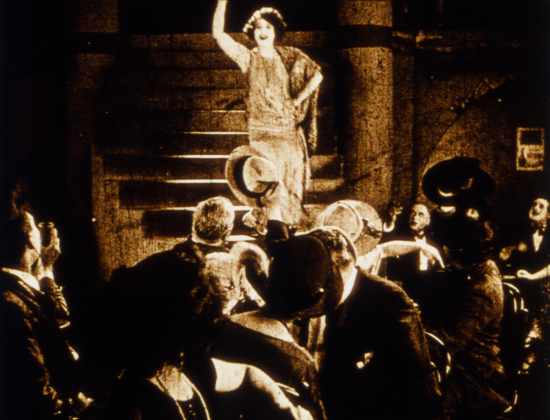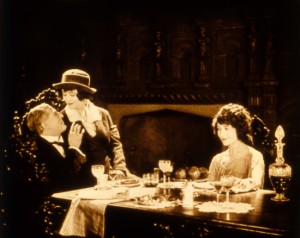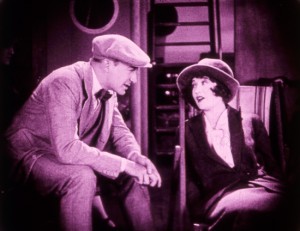From now through January 25, the National Film Preservation Foundation is offering you the opportunity to stream, for free, what survives from The White Shadow (1924). Directed by Graham Cutts and starring Betty Compson and Clive Brook, this moody, convoluted melodrama is also the earliest extant credit for Alfred Hitchcock. Twenty-four-years old, he was credited as art director and assistant director. More important, he wrote the screenplay and edited the film.
I wrote about the rediscovery of The White Shadow earlier in “Behind the Lost Hitchcock Film.” But although the surviving elements—about forty minutes, roughly the first half of the story—have been preserved, the film itself has not been easy to see. Now, thanks to the NFPF, Fandor, and the For the Love of Film Blogathon, everyone can see and judge The White Shadow.
Critics of the time found the story to The White Shadow preposterous, and it’s hard to defend a plot that inflicts so much damage on twin sisters Nancy (a girl without a soul, or “white shadow”) and Georgina (a prim, retiring type who nevertheless tries to steal her sister’s lover). For good measure, there’s a heartless father who goes insane and a mother driven to death by her family’s theatrics.
It’s tempting to look for clues to Hitchcock’s later career while watching The White Shadow. Does the Brent twins’ country estate in Devon resemble Manderley in Rebecca, or Bruno’s mansion in Strangers on a Train? When Hitchcock constructed a nightclub climax for Young and Innocent, did he remember The Cat Who Laughs cabaret here? Would Hitchcock find inspiration later on from The White Shadow‘s tense and expertly staged horse jumping scene? Maybe, maybe not.
It’s important to remember that this is a Graham Cutts film, not a Hitchcock film, and that Cutts had ultimate say over how scenes would play and actors perform. The director obtained restrained, realistic performances from his stars at a time when some films still had actors gesticulating wildly. Cutts favored two camera set-ups: far away from the action, and even farther away. While there are occasional close-ups and angled shots, The White Shadow never quite overcomes a dead-on, straight-ahead point-of-view, as if viewers were watching actors on a stage. Within just a few years, Hitchcock would be employing a much more wide-ranging, cinematic point-of-view in films like The Lodger.
Watching The White Shadow, we’re reminded how much easier it was on certain levels to make silent films. Without much effort, Betty Compson, an American actress, could play British, and the British Clive Brook could pretend to be American. When the twins’ parents (A.B. Imeson and Daisy Campbell) have an argument, they can say anything they want—all we see are their lips moving. And all it took for a director to introduce a character was a static close-up. Want to take everyone to Paris? Just add an intertitle (“In Paris at the Cabaret of The Cat Who Laughs”) and a wide shot of a studio set, and there you are.
Today we can be impressed by the film’s tinting scheme, its fairly sophisticated split-screen techniques (to allow both twins to appear in the same frame), and a persuasive use of day-for-night cinematography. More worrisome is the nitrate decomposition, especially evident in the opening shots. (Also of note: Michael Mortilla’s excellent score for piano, violin, and percussion.)
Hitchcock continued to make overwrought melodramas like this throughout his career. He just learned to disguise their improbable narrative twists with black humor and bravura pieces of “pure cinema,” the breathtaking sequences that earned him the nickname “Master of Suspense.”
Compson worked at Paramount back in the US, making a strong impression in Josef von Sternberg’s Docks of New York. Brook also worked with Sternberg, and Marlene Dietrich, on Shanghai Express. The White Shadow was released in the US as White Shadows by Lewis J. Selznick Enterprises. Years later, Selznick’s son David O. would bring Hitchcock to Hollywood to make Rebecca.
The White Shadow was not a success, either with critics or filmgoers. But it’s a good example of what could be found in the marketplace in 1924. The NFPF website offers several other films for streaming, some with musical accompaniment. They include cartoons, Westerns, travelogues, romances, and comedies. Try the captivating Tropical Nights, a Caribbean sojourn in color, or A Modern Cinderella, a 1910 updating of the fairy tale filmed in New York by Vitagraph.
And consider making a donation to the NFPF, a crucial organization that deserves your support.





